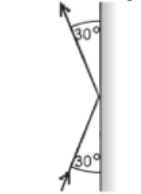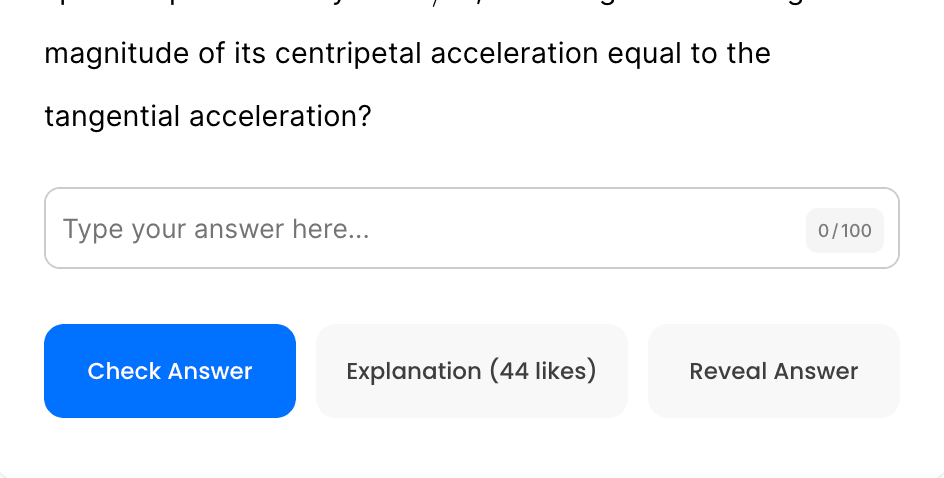In a demonstration, a teacher holds the axle of a wheel that is spinning with constant angular speed. The teacher then releases the axle and the wheel begins to fall toward the ground. As the wheel falls, its angular speed remains constant. Which of the following correctly describes how the rotational kinetic energy \( K_{\text{rot}} \) of the wheel and the total kinetic energy \( K_{\text{tot}} \) of the wheel change, if at all, after the wheel is released but before it reaches the ground?
| \( K_{\text{rot}} \) | \( K_{\text{tot}} \) | |
|---|---|---|
| A | Constant | Constant |
| B | Constant | Increasing |
| C | Increasing | Constant |
| D | Increasing | Increasing |
A baseball is hit high and far across a field. Which of the following statements is true? At the highest point:

A super dart of mass \(20 \, \text{g}\), traveling at \(350 \, \text{m/s}\), strikes a steel plate at an angle of \(30^\circ\) with the plane of the plate, as shown in the figure. It bounces off the plate at the same angle but at a speed of \(320 \, \text{m/s}\). What is the magnitude of the impulse that the plate gives to the bullet?
A rubber ball bounces off of a wall with an initial speed \(v\) and reverses its direction so its speed is \(v\) right after the bounce. As a result of this bounce, which of the following quantities of the ball are conserved?
A rubber ball and a lump of clay have equal mass. They are thrown with equal speed against a wall. The ball bounces back with nearly the same speed with which it hit. The clay sticks to the wall. Which one of these objects experiences the greater impulse?
A mechanical wheel initially at rest on the floor begins rolling forward with an angular acceleration of \( 2\pi \, \text{rad/s}^2 \). If the wheel has a radius of \( 2 \, \text{m} \), what distance does the wheel travel in \( 3 \) seconds?
If you want to double the momentum of a gas molecule, by what factor must you increase its kinetic energy?
A race car travels in a circular track of radius \( 200 \) \( \text{m} \). If the car moves with a constant speed of \( 80 \) \( \text{m/s} \),
Find the approximate minimum mass needed for a spherical ball with a \(40\) \(\text{cm}\) radius to sink in a liquid of density \(1.4 \times 10^3\) \(\text{kg/m}^3\). Use \(9.8 \text{m/s}^2\) for \(g\).
A \( 7.3 \) \( \text{kg} \) mass is placed on a spring with a spring constant of \( 34 \) \( \text{N/cm} \). How much does this stretch the spring?
A karate master is about to split a piece of wood with her hand. Select all she must do in order to deliver the maximum force to split the wood.
Two uniform solid balls, one of radius \( R \) and mass \( M \), the other of radius \( 2R \) and mass \( 8M \), roll down a high incline. They start together from rest at the top of the incline. Which one will reach the bottom of the incline first?
By continuing you (1) agree to our Terms of Use and Terms of Sale and (2) consent to sharing your IP and browser information used by this site’s security protocols as outlined in our Privacy Policy.
Quick Start Guide
AP physics 1, AP C, honors and advanced physics students.
Quickly filter questions by units and more.


Here’s guide to using 5 UBQ filters.
GQ = general question, MCQ = multiple choice, FRQ = free response.


Click the check or bookmark button.
Now you’ll be able to see completed or bookmarked questions at a glance!
Answer keys, personalized for you.

Phy will be responsible for grading your FRQs and GQs.
No more copy and pasting. Just solve and snap.
Questions for Mastery

By continuing you agree to nerd-notes.com Terms of Service, Privacy Policy, and our usage of user data.